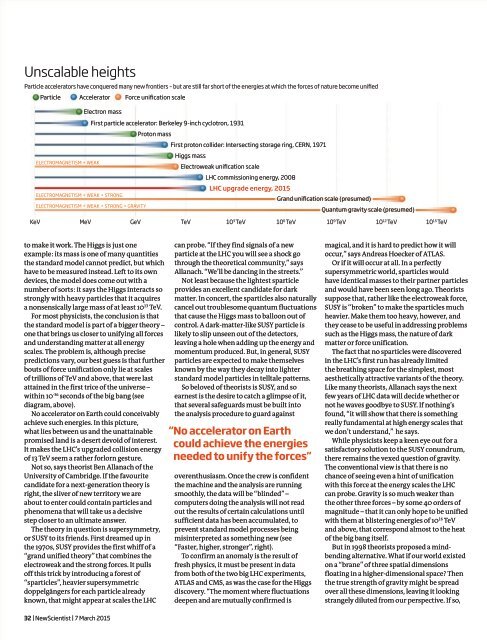New Scientist Magazine - No. 3011
New Scientist Magazine - No. 3011
New Scientist Magazine - No. 3011
You also want an ePaper? Increase the reach of your titles
YUMPU automatically turns print PDFs into web optimized ePapers that Google loves.
Unscalable heightsParticle accelerators have conquered many new frontiers – but are still far short of the energies at which the forces of nature become unifiedParticle Accelerator Force unification scaleElectron massFirst particle accelerator: Berkeley 9-inch cyclotron, 1931Proton massFirst proton collider: Intersecting storage ring, CERN, 1971Higgs massELECTROMAGNETISM + WEAKElectroweak unification scaleLHC commissioning energy, 2008LHC upgrade energy, 2015ELECTROMAGNETISM + WEAK + STRONGELECTROMAGNETISM + WEAK + STRONG + GRAVITYGrand unification scale (presumed)Quantum gravity scale (presumed)KeV MeV GeV TeV 10 3 TeV 10 6 TeV 10 9 TeV 10 12 TeV 10 15 TeVto make it work. The Higgs is just oneexample: its mass is one of many quantitiesthe standard model cannot predict, but whichhave to be measured instead. Left to its owndevices, the model does come out with anumber of sorts: it says the Higgs interacts sostrongly with heavy particles that it acquiresa nonsensically large mass of at least 10 13 TeV.For most physicists, the conclusion is thatthe standard model is part of a bigger theory –one that brings us closer to unifying all forcesand understanding matter at all energyscales. The problem is, although precisepredictions vary, our best guess is that furtherbouts of force unification only lie at scalesof trillions of TeV and above, that were lastattained in the first trice of the universe –within 10 -36 seconds of the big bang (seediagram, above).<strong>No</strong> accelerator on Earth could conceivablyachieve such energies. In this picture,what lies between us and the unattainablepromised land is a desert devoid of interest.It makes the LHC’s upgraded collision energyof 13 TeV seem a rather forlorn gesture.<strong>No</strong>t so, says theorist Ben Allanach of theUniversity of Cambridge. If the favouritecandidate for a next-generation theory isright, the sliver of new territory we areabout to enter could contain particles andphenomena that will take us a decisivestep closer to an ultimate answer.The theory in question is supersymmetry,or SUSY to its friends. First dreamed up inthe 1970s, SUSY provides the first whiff of a“grand unified theory” that combines theelectroweak and the strong forces. It pullsoff this trick by introducing a forest of“sparticles”, heavier supersymmetricdoppelgängers for each particle alreadyknown, that might appear at scales the LHCcan probe. “If they find signals of a newparticle at the LHC you will see a shock gothrough the theoretical community,” saysAllanach. “We’ll be dancing in the streets.”<strong>No</strong>t least because the lightest sparticleprovides an excellent candidate for darkmatter. In concert, the sparticles also naturallycancel out troublesome quantum fluctuationsthat cause the Higgs mass to balloon out ofcontrol. A dark-matter-like SUSY particle islikely to slip unseen out of the detectors,leaving a hole when adding up the energy andmomentum produced. But, in general, SUSYparticles are expected to make themselvesknown by the way they decay into lighterstandard model particles in telltale patterns.So beloved of theorists is SUSY, and soearnest is the desire to catch a glimpse of it,that several safeguards must be built intothe analysis procedure to guard against“ <strong>No</strong> accelerator on Earthcould achieve the energiesneeded to unify the forces”overenthusiasm. Once the crew is confidentthe machine and the analysis are runningsmoothly, the data will be “blinded” –computers doing the analysis will not readout the results of certain calculations untilsufficient data has been accumulated, toprevent standard model processes beingmisinterpreted as something new (see“Faster, higher, stronger”, right).To confirm an anomaly is the result offresh physics, it must be present in datafrom both of the two big LHC experiments,ATLAS and CMS, as was the case for the Higgsdiscovery. “The moment where fluctuationsdeepen and are mutually confirmed ismagical, and it is hard to predict how it willoccur,” says Andreas Hoecker of ATLAS.Or if it will occur at all. In a perfectlysupersymmetric world, sparticles wouldhave identical masses to their partner particlesand would have been seen long ago. Theoristssuppose that, rather like the electroweak force,SUSY is “broken” to make the sparticles muchheavier. Make them too heavy, however, andthey cease to be useful in addressing problemssuch as the Higgs mass, the nature of darkmatter or force unification.The fact that no sparticles were discoveredin the LHC’s first run has already limitedthe breathing space for the simplest, mostaesthetically attractive variants of the theory.Like many theorists, Allanach says the nextfew years of LHC data will decide whether ornot he waves goodbye to SUSY. If nothing’sfound, “it will show that there is somethingreally fundamental at high energy scales thatwe don’t understand,” he says.While physicists keep a keen eye out for asatisfactory solution to the SUSY conundrum,there remains the vexed question of gravity.The conventional view is that there is nochance of seeing even a hint of unificationwith this force at the energy scales the LHCcan probe. Gravity is so much weaker thanthe other three forces – by some 40 orders ofmagnitude – that it can only hope to be unifiedwith them at blistering energies of 10 16 TeVand above, that correspond almost to the heatof the big bang itself.But in 1998 theorists proposed a mindbendingalternative. What if our world existedon a “brane” of three spatial dimensionsfloating in a higher-dimensional space? Thenthe true strength of gravity might be spreadover all these dimensions, leaving it lookingstrangely diluted from our perspective. If so,32 | <strong>New</strong><strong>Scientist</strong> | 7 March 2015


